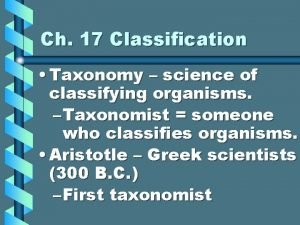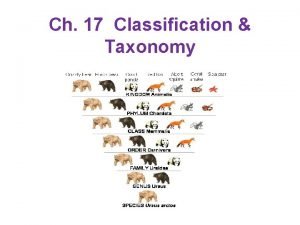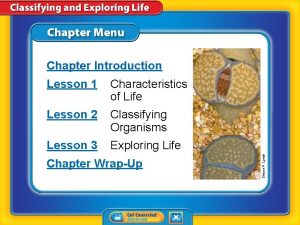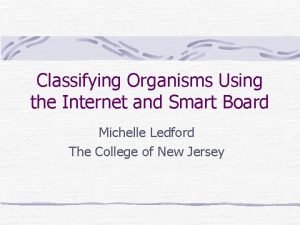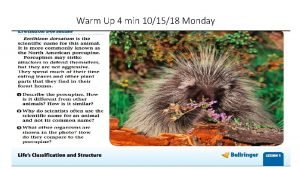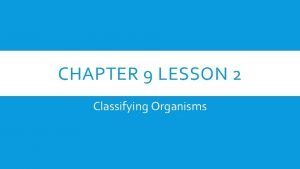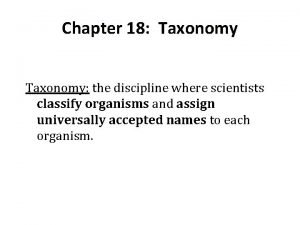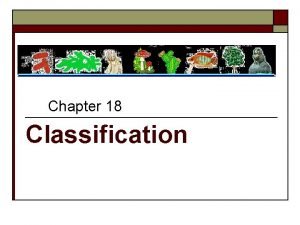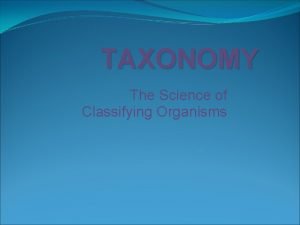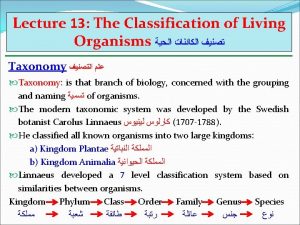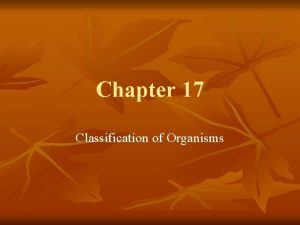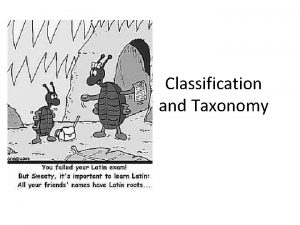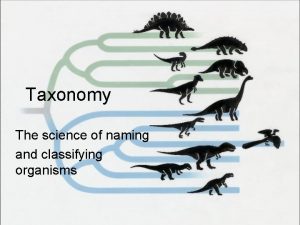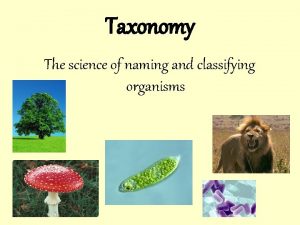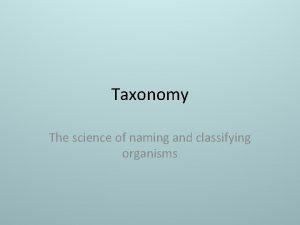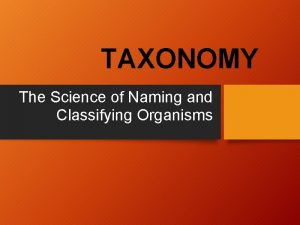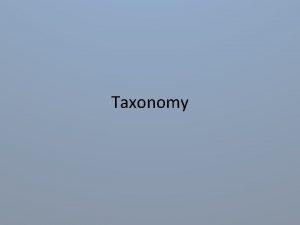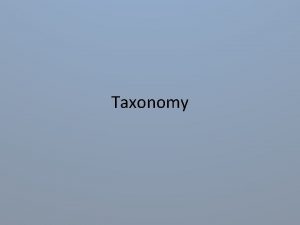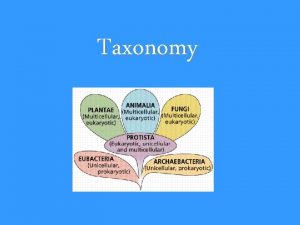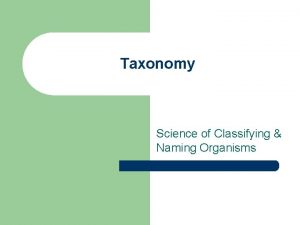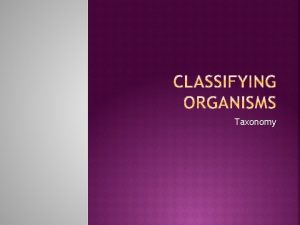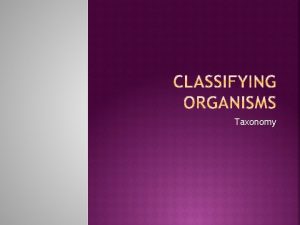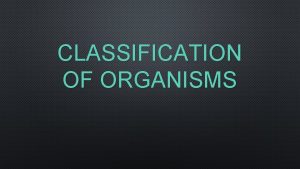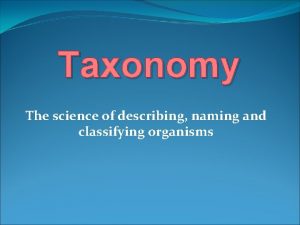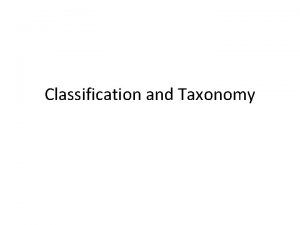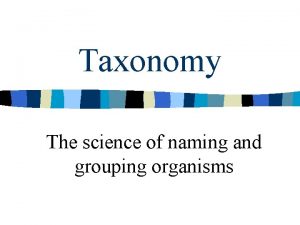TAXONOMY the science of naming and classifying organisms























- Slides: 23

TAXONOMY- the science of naming and classifying organisms • Aristotle: grouped plants and animals based on similarities • Greeks & Romans-major groups called “genus” (means group) • Carl Linnaeus-(1707 -1778) - Sweden-gave organisms a 2 word name. . .

Binomial Nomenclature • Means “ 2 word naming system” • 2 words are – Genus (1 st word— 1 st letter always capitalized) – species (2 nd word—all lower case) • Both words should either be underlined or in italics (italics only if typed) • this is considered the Scientific name!

Universal Language = Latin • Provides a standard for communication among biologists, regardless of their native language • 2 different organisms cannot have the same scientific name • organisms can share one part of their scientific name w/another organism.

Hierarchical System • • Domain Kingdom Dear King Phillip Came Over For Good Soup Phylum Class Order Family Genus {SCIENTIFIC NAME} species

5 or 6 Kingdoms? • 5 Kingdom System: Monera (Bacteria), Protista, Fungi, Plantae, Animalia • 6 Kingdom System: Archaebacteria, Eubacteria, Protista, Fungi, Plantae, Animalia

Species • Generally defined as a group of organisms that can breed to produce fertile offspring • All dogs are one species • Horses and donkeys are different species because when they breed, their offspring (mules) are sterile!

Phylogenetic Tree • Branched diagram that represents relationships of organisms • Clues to relationships found – Fossil record – Comparative anatomy and physiology – Correlation of DNA

http: //images. google. com/imgres? imgurl=http: //www. med. nyu. edu/rcr/course/tree. gif&imgrefurl=http: //www. med. nyu. edu/rcr/course/intro-6. html&h=277&w=320&sz=3&tbnid=ic 9 o. H 7 Qgwma. Wl. M: &tbnh=102&tbnw=118&prev=/images%3 Fq%3 Dphylogenetic%2 Btree%26 um%3 D 1&start=2&sa=X&oi=images&ct=image&cd=2

DICHOTOMOUS KEYS • Key used to identify something, like organisms • Uses pairs of contrasting descriptions (A or B) • The correct description either leads to another pair of descriptions or identifies the object. • Always start at #1 each time you use one.

Help! Scientists have discovered quite a few new creatures on planet Pamishan. They need your help to identify and classify them. Use the dichotomous key to identify these creatures. 1 2

Planet Pamishan

6 Kingdoms • • • Archaebacteria Eubacteria Protista Fungi Plantae Animalia • These 2 are sometimes combined together to form the Monera Kingdom when only 5 Kingdoms are used

Cell Types Prokaryotes Eukaryotes • No nucleus • No membrane-bound organelles • Most 1 -10 μm in size • Evolved 3. 5 billion years ago • Only Archaebacteria and Eubacteria Kingdoms • Has nucleus • Many organelles • Many 2 -1, 000 μm in size • Evolved 1. 5 billion years ago • Includes Protista, Fungi, Plantae and Animalia Kingdoms

Types of Nutrition: Autotrophs or Heterotrophs • Autotrophs: 1. ) photosynthetic -organism that uses energy from the sun to make its own food 2. ) chemosynthetic -simple nonliving chemical nutrients such as H 2 S, sulfur, and iron is consumed and made into living tissue; makes its own food. *All autotrophs make their own food! • Heterotrophs: organisms that cannot make its own food—must eat other organisms or organic wastes • Absorbers: produces enzymes that break down food particles outside its body, then absorbs the digested molecules

Bacteria Shapes Coccus (spherical shaped) Bacillus (rod shaped) Singular Coccus Bacillus Spirillum(spiral/curved walls) Plural cocci bacilli spirilla

methanic halophile sulfurous


Bacterial Fossils of blue-green algae cyanobacteria 2. 6 billion years old 3. 2 billion years old Algal mats preserved in rock Modern day

Eukaryotic Cells – Kingdoms Protista, Fungi, Plantae and Animalia Protists – yellow; fungi – red; plantae – green; animalia - blue

Kingdom Protista from microscopic to 150 feet large (the “catch-all kingdom”)



 Homo taxonomy
Homo taxonomy Canis latrans classification
Canis latrans classification Human domain and kingdom
Human domain and kingdom The scientific discipline of classifying organisms
The scientific discipline of classifying organisms Discipline of classifying and naming organisms
Discipline of classifying and naming organisms Discipline of classifying and naming organisms
Discipline of classifying and naming organisms Liger taxonomy
Liger taxonomy Most general to most specific classification
Most general to most specific classification Biology
Biology Marzano and kendall's new taxonomy example
Marzano and kendall's new taxonomy example Unicellular and multi cellular
Unicellular and multi cellular Classifying and exploring life lesson 1 answer key
Classifying and exploring life lesson 1 answer key Classifying organisms worksheet
Classifying organisms worksheet Lesson outline classifying organisms
Lesson outline classifying organisms Lesson 2 classifying organisms answer key
Lesson 2 classifying organisms answer key The scientific discipline of classifying organisms
The scientific discipline of classifying organisms What are the rules for writing scientific names
What are the rules for writing scientific names Organisms taxonomy
Organisms taxonomy Levels of classification
Levels of classification 8 major levels of classification
8 major levels of classification Organisms taxonomy
Organisms taxonomy Member of the same species
Member of the same species Talk about your favorite subject at school
Talk about your favorite subject at school Observing in science process skills
Observing in science process skills





